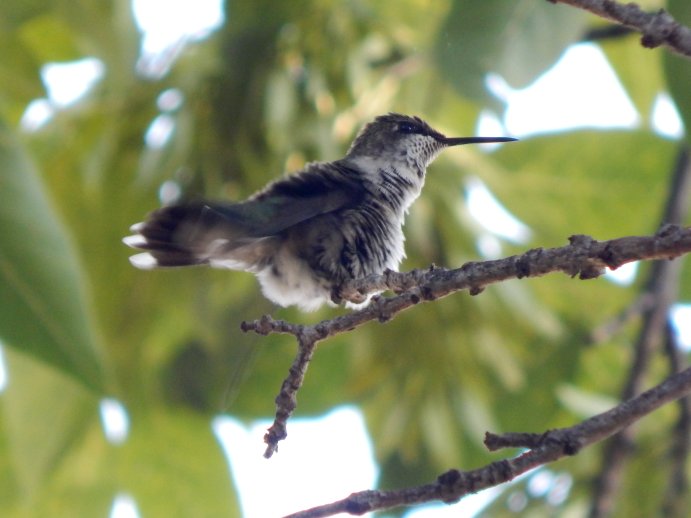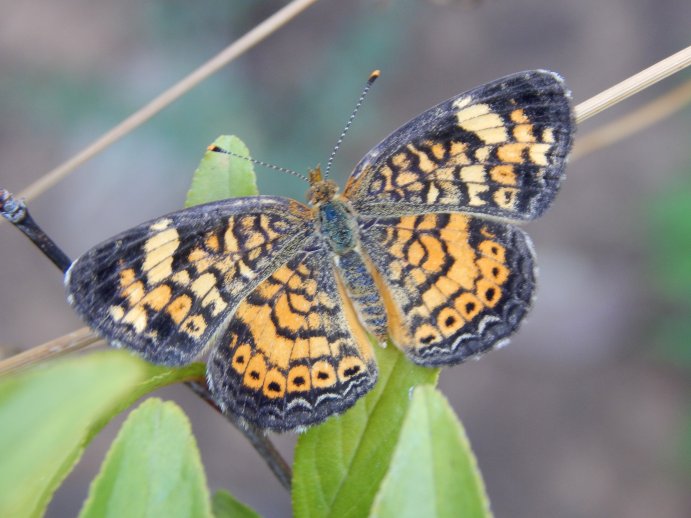Lately it seems that before I can turn around, another month has gone by. Does it appear that way to everyone else? I’ve always heard that the older you get, the faster time flies. I hate to see what it might be like in another ten years! Anyway, it’s the first Wednesday of the month once again and time for Wildlife Wednesday, hosted by Tina and her blog My Gardener Says. I’ve been a bit neglectful of my blog over the past month. There really hasn’t been that much out of the ordinary wildlife in my garden and the hot temperatures have kept me mostly inside except for early mornings. The one example of wildlife really worth celebrating this month has to be the Ruby-Throated Hummingbirds (Archilochus colubris) that have been making their presence known. I hope you’ll excuse me if I go overboard!

Though I’ve had feeders out all summer, the Hummers have been busy ignoring them and keeping themselves busy feeding on the flowering plants, most notably Trumpet Vine (Campsis radicans) and Turk’s Cap (Malvaviscus arboreus). The blooms on both of these have about gone to the wayside, finally inducing these little garden denizens to take a chance on the magic liquid contained in the feeders.

Have you ever just settled down in a chair in front of a window or on the porch and watched Hummingbirds go about their business? If you haven’t then you’re really missing out on a spellbinding experience. These little (immature) guys or gals have been zipping around our garden, chasing each other and visibly staking out their territories.

Once they find a prime feeding area they stick close by, usually within just a few feet or so of a feeder.

They invariably perch on the same little twig in order to keep an eye on their food source.

If another of their kind happens by, a wonderful-to-watch chase scene ensues. If only I could have captured one such flight with my camera! I envy those who’ve been able to do so.

The Texas Parks and Wildlife Department conducts an annual survey of Hummingbirds called the Texas Hummingbird Roundup.

For those of you living in Texas here’s a link to information about the Texas Hummingbird Roundup as well as a link to the Texas Hummingbird Roundup Backyard Survey.

While I see Ruby-throated Hummingbirds throughout the day, they seem to be most active in the early morning and late evening.

Look at the length of that bill!

They’re such tiny birds, measuring from about 2.8 inches to to 3.5 inches in length and weighing just fractions of an ounce!

For information on the Ruby-throated Hummingbird be sure to visit this page at the Cornell Lab of Ornithology website.
So what other wildlife did I see in my garden this month? Here are a few other birds…
…a Carolina Wren (Thryothorus ludovicianus) hopping around on some deck furniture. For being so small, these birds have a very loud voice. Carolina Wren pairs stay together for life!

…a White-winged Dove (Zenaida asiatica) sunbathing. The colors of this bird’s feathers form quite a contrast. Many birds exhibit colors in flight, or in a posture such as this, that you don’t normally see when they’re just perching on a utility wire or hopping around on the ground. White-winged Doves are now seen as far north as Alaska!

…a European Starling (Sturnus vulgaris) in the transitional juvenile form. Starlings can learn the calls of up to twenty other species of birds!

…a couple of juvenile Northern Mockingbirds (Mimus polyglottos). We didn’t seem to have many Mockingbirds this summer, yet young ones are beginning to prance around the yard in numbers. These two have been keeping fast company — perhaps they’re siblings? — and still exhibit some speckling on their upper breast and throat areas. Mockingbirds feed on insects and fruit!

And here are a few bugs…
…an Eastern Pondhawk (Erythemis simplicicollis) Dragonfly. I haven’t seen as many Dragonflies lately, but this one hung around long enough for me to take a few pictures.

…and a Pearl Crescent (Phyciodes tharos) Butterfly. These seem to come and go in small bunches. They visit for a while, disappear, then return.

That’s my Wildlife Wednesday post for September 2015. Please check out Tina and her blog My Gardener Says for more Wildlife Wednesday posts!
Another fun post! I too am absolutely fascinated by the territorial air show put on by hummingbirds each year. They are amazing in flight, really fun to watch, though I’m never sure how seriously they take each other. Do they have as much fun chasing each other as we do watching? I’ll admit I often wish they’d just settle down and drink, already!
Great shots of that tiny Pearl Crescent. One got in our house accidentally the other day and I thought our cats would lose their minds trying to jump high enough to bat it to the floor. Happily I can report we managed to corral the felines and usher the butterfly back out the way it came in.
I understand what you mean about time flying. I’m sincerely hoping September will s l o w w a y d o w n because there is so much to do in the garden this time of year. Here’s to the end of summer at last!
LikeLike
Sometimes when you’re living life, blogging takes a back seat–and that’s just fine, though I must admit, I’ve missed your posts. Thanks for joining in though, for Wildlife Wednesday.
For someone who says she doesn’t have much, you sure have a lot!! Though you’re right that the heat has been relentless. You take the best bird shots–wow! The hummer photos are so impressive, one after another, they get better and better. The pondhawk and butterfly are also great shots; I get pondhawks, but not sure I’ve had any pearl crescents in my garden–I need to keep an eye out for them.
LikeLike
Great hummingbird shots! Hummingbird watching is one of my favorite activities. When they are sparing with each other, they will fly right over me. I am obsessed with them too and I’m watching two of them duke it out from my window.
LikeLike
We haven’t any hummingbirds over here and its so cold, I’ve just flicked the heating on for the first time, I know its very hot over there but I am envying you some Hummingbird watching and your heat. Interesting photo of the European Starling, I haven’t seen a young bird with such distinct juvenile markings over here, I wonder if they have evolved differently. You have taken a great photo of the Eastern Pondhawk Dragonfly, what beautiful markings it has. I know am really late too but I am going to put together something for your latest Bucket List before its your next one!
LikeLike
Hummingbirds are a delight in our garden. I always make sure I have red-flowers like Calibrachoa for them to sip. I even have left a dead tree in the yard because they use it for perching. Some may say it is an eyesore, but even in death it teems with life – lichen, insects, woodpeckers, etc.
Love the photo of the Eastern Pondhawk. 🙂
LikeLike
I like your eastern pondhawk dragonfly, the bird photos are lovely Anna, no as Julie says there are no hummingbirds here in Britain so I’ve never seen them for real, it sounds nice to just sit and watch the birds in a warm dry atmosphere, I’ll swap you our cold and wet, your Carolina wren looks sweet like our wren which doesn’t have the eyebrow, I see them in the garden all year,
I feel time is sometimes going so fast it is like flicking the pages of a book, it means we are not bored, Frances
LikeLike
A most enjoyable post, and wonderful pictures. sadly we don’t get hummingbirds here in the UK.
As for time going faster as you get older I certainly think that it does. xx
LikeLike
Such great pictures of the ruby-throated hummingbird together with your amusing descriptions of their behaviour. How lucky you are to be able to watch them all summer. Beautiful markings on that dragonfly too.
LikeLike
Again great images and info – I especially envy you for the hummingbirds pictures! I never seem to manage to capture them. And the pondhawk dragonfly is gorgeous!
LikeLike
These photographs are stunning. Have you thought of putting them in a book? What a wonderful gift you have. Also, you have the gift of encouragement. I love reading your comments on my blog.
LikeLike
Like you I adore watching the hummers here from spring until they leave in fall. The mature males are gone now and so we see the females and juveniles fighting over prime feeding areas…Your pics are just stunning!
LikeLike
Oh thanks so much for sharing these. I just love hummers but I rarely see them.
LikeLike